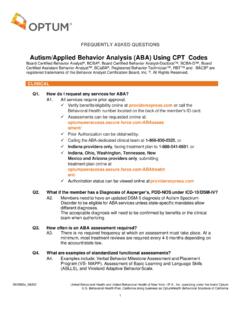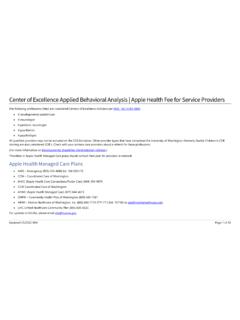Transcription of Applied Behavior Analysis (ABA) Parent Training Handouts
1 Applied Behavior Analysis (ABA) Parent Training Handouts 1 Parent Training - Introduction to ABA Objective: Parents will demonstrate knowledge of skills by completing quizzes and exercises associated with topics (A-E) with 90% accuracy and independence. Topic A: Introduction to Applied Behavior Analysis (ABA) parents will learn basic components of ABA, its utility and effectiveness in treating autism. Applied Behavior Analysis (ABA) is the science to understanding Behavior and has become a widely accepted and effective treatment for children with Autism Spectrum Disorder (ASD).
2 ABA focuses on improving socially significant behaviors ( , anything important) to a meaningful degree and relies on assessment, individualized instruction, and structured teaching programs in order to measure Behavior change. Key Features of ABA: As Applied to Children with Autism Adapted From Cambridge Center for Behavioral Studies [2001] The child s Behavior is assessed through direct observations that focus on exactly what the child does, when he/she does it, at what rate and what happens before (antecedents) as well as what happens after Behavior (consequences). Strengths and weaknesses are specified in this way.
3 Skills that the child does not demonstrate but are expected based on age, are chosen for instruction. Initially, pairing is used to condition the behaviorist as a reinforcer and gradually instructional control is attained. This creates a lasting foundation to facilitate Behavior change. Teaching methods are individualized based on what technic would be appropriate for the child ( , DTT/NET). Many opportunities to practice and learn a skill are given repeatedly in structured teaching situations and in the course of everyday activities.
4 The number of opportunities depends on the individual needs of each child. Instruction initially emphasizes teaching a child how to learn -- to listen, to watch, to imitate and then continues to builds on these skills. As the child progresses, guidance is systematically reduced so that the child is responding independently; prompts are faded out. As steps are acquired, the child is taught to combine them in more complex ways and to practice them in more situations. Problem Behavior is not reinforced. The child is not allowed to escape from learning through non-socially desirable means and is redirected to engage in appropriate 2 Behavior .
5 The child s responses during every lesson are recorded. These data are used to determine if he or she is progressing at an acceptable rate. If not, changes are made. Recording child Behavior is essential because we need to SEE that the program is working. Observing therapist Behavior tells us that the procedures are being followed correctly and consistently. The information adds to our knowledge about the effectiveness of procedures and how to avoid and overcome problems that may arise in practice. Types of Interventions ABA is an evolving science.
6 Achieve Beyond is committed to critically examining all new techniques and integrating them into our staff- Training program when applicable. At present, we believe the following techniques to be essential in a program for most children diagnosed with PDD: Discrete Trial Teaching (promotes quick skill acquisition) Incidental Teaching (promotes student initiations) Natural Environment Teaching (promotes generalization of learned skills) Other techniques such as independent activity schedules, script fading, token economy, video modeling, peer modeling, and Behavior contracts may be used if needed.
7 Our practices are only limited by those practices not based on research. Parent /Guardian Exercise Describe some behaviors that are socially significant to you, as it pertains to your child. Parent /Guardian Quiz 1. What is ABA? _____ 2. What does it focus on? _____ 1 Parent Training - Behavior Objective: Parents will demonstrate knowledge of skills by completing quizzes and exercises associated with topics (A-E) with 90% accuracy and independence. Topic B: Identifying and Measuring Problem Behaviors parents will learn to describe behaviors in objective and measurable terms and will learn the components of Behavior measurement.
8 In order to improve socially significant behaviors, Behavior itself must be defined. Behavior is anything an organism does or says . Key Features of Behavior Behavior impacts the environment. Each Behavior selected for change must be individually described and defined using verbs, or action words. When describing Behavior , the focus must be on features that are observable and measurable and we must refrain from subjective input (opinions and feelings). Again, the focus must be on observable overt features (things that are seen) rather than covert features (things that are unseen, hidden, or internal).
9 An operational definition is a way of describing Behavior in specific, concise, observable, and measurable terms. We use operational definitions of Behavior in order to pin point what Behavior we intend to address. Without a clear definition, we are unable to specify what our target will be, cannot decide on, or implement strategies, cannot determine how to collect Behavior data, and cannot measure change for the good or bad. Examples: o Bad: John is nervous. o Good: John paces the room back and forth, rubbing his hands, and breathing rapidly. o Bad: Jane is disruptive. o Good: Jane vocally blurts out comments loud enough for the students in her class to hear, while the teacher is speaking.
10 Parent /Guardian Exercise Choose a Behavior . Practice writing an operational definition in the space below. Behavior : _____ 2 Types of Behavior Data Measurement Antecedent Behavior Consequence (ABC) Data: data are collected on the sequence of events surrounding a behavioral episode. This type of data helps identify what triggers the Behavior and what purpose the Behavior serves. o To collect this type of data you must describe the following: Antecedent (A): what happened immediately right before the Behavior ? Behavior (B): what was observed and said. Consequence: what happened immediately right after the Behavior ?







